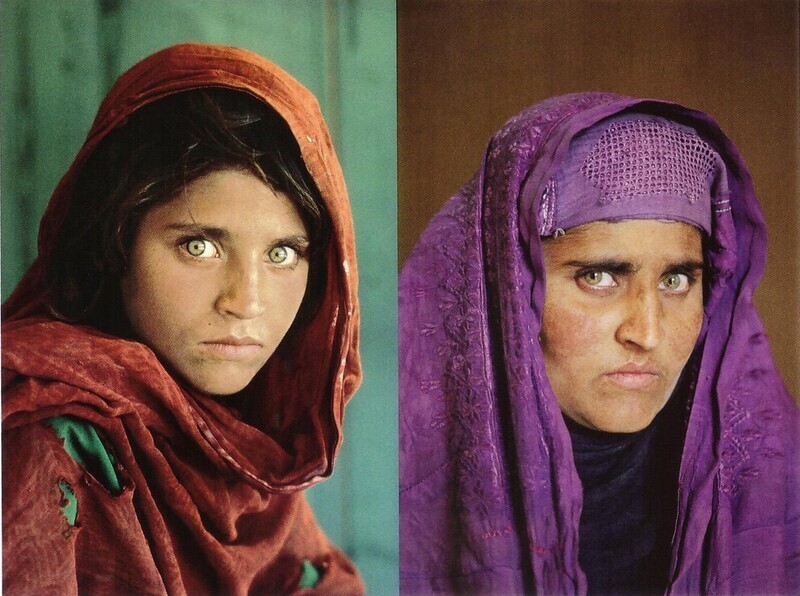hankyoreh
Links to other country sites 다른 나라 사이트 링크
[Column] Is “Afghan Girl” doing well?

Sometimes photographs are shot under the same circumstances, and against the same backdrop, as an earlier photograph — they’re known as “before-and-after photographs.”
One of the main places such photographs are taken is the hospital. When people have a physical condition, for example, CAT scans or ultrasounds are often taken several months apart to monitor changes. The patient’s condition is also photographed with an ordinary camera before and after a cosmetic operation performed by a dentist, plastic surgeon, or dermatologist.
Before-and-after photographs are also used in news reports about disasters and wars, since they make it easy to see how the situation has changed over time. After COVID-19 comes to an end, for example, newspapers are sure to run photographs showing what conditions were like before and after the pandemic, under a headline screaming, “It’s finally over!”
I bet that one of those photographs will show nearly empty streets with a handful of masked people walking around, while another will show streets crowded with laughing people strolling hand in hand.
In April 2002, National Geographic ran before-and-after photographs of a certain woman. Many readers would have remembered the photograph of a girl 17 years before — the unnamed “Afghan girl” who’d been on the cover of the same magazine in June 1985.
The girl gazed straight at the camera, her big round eyes full of fear. As her photograph made its way around the world, people came to associate her with the refugee issue and with conflict in Afghanistan.
The person on the other end of the camera lens was Steve McCurry, an American photojournalist born in 1950. The twelve-year-old girl that he first saw in a refugee camp had lost her parents in a Soviet helicopter attack. Afterward, she and her grandmother, older brother, and younger sisters had to flee on foot over snow-covered mountains.
The girl had only crossed paths briefly with McCurry, but he couldn’t get her out of his head, even after returning to the US. Meanwhile, the Afghan people’s suffering continued, trapped between corrupt governments and the Taliban.
When McCurry tried to track down the Afghan girl, some people said they knew her, others said they were her, and still others said their wives looked exactly like her. But none of those women had the gleam he remembered seeing in the girl’s eyes.
In 2002, one year after the 9/11 terrorist attacks, McCurry and the National Geographic team were dispatched to Afghanistan once again. That was when McCurry was finally reunited with the Afghan girl.
The original photograph made it possible to confirm this woman was the original model through iris pattern recognition. Time had left its marks on her, but those vivid green irises, which seemed so wary of other people, were the same.
Her name was Sharbat Gula. Born in 1972, Gula was 30 years old when she was reunited with McCurry. She’d been married at the age of 13 and had four children since then.
While Gula remembered that someone had once taken a picture of her, she was living at home, unaware of how famous her face had become.
The National Geographic team used charitable donations to cover medical bills for Gula’s family and expressed their hope that she would live at peace in Kabul after they departed.
Nineteen more years have passed since then. Kabul has become a locus of conflict, and oppression of women has grown even worse than before.
What is the intended message of before-and-after photographs? The photographs are needed to highlight a happy ending, to proclaim that things are better than they used to be. They’re designed to reassure us that vexations and gloom have passed and that freedom and peace are upon us.
They carry an implicit hope not only for change, but for ideal change. While I’m curious about what 30-year-old Gula is like today, I honestly don’t have the courage to face her reality. I’m not confident that her life over there has gotten any better.

By Lee Joo-eun, professor of culture contents at Konkuk University
Please direct comments or questions to [english@hani.co.kr]

Editorial・opinion
![[Column] Has Korea, too, crossed the Rubicon on China? [Column] Has Korea, too, crossed the Rubicon on China?](https://flexible.img.hani.co.kr/flexible/normal/500/300/imgdb/original/2024/0419/9317135153409185.jpg) [Column] Has Korea, too, crossed the Rubicon on China?
[Column] Has Korea, too, crossed the Rubicon on China?![[Correspondent’s column] In Japan’s alliance with US, echoes of its past alliances with UK [Correspondent’s column] In Japan’s alliance with US, echoes of its past alliances with UK](https://flexible.img.hani.co.kr/flexible/normal/500/300/imgdb/original/2024/0419/2317135166563519.jpg) [Correspondent’s column] In Japan’s alliance with US, echoes of its past alliances with UK
[Correspondent’s column] In Japan’s alliance with US, echoes of its past alliances with UK- [Editorial] Does Yoon think the Korean public is wrong?
- [Editorial] As it bolsters its alliance with US, Japan must be accountable for past
- [Guest essay] Amending the Constitution is Yoon’s key to leaving office in public’s good graces
- [Editorial] 10 years on, lessons of Sewol tragedy must never be forgotten
- [Column] A death blow to Korea’s prosecutor politics
- [Correspondent’s column] The US and the end of Japanese pacifism
- [Guest essay] How Korea turned its trainee doctors into monsters
- [Guest essay] As someone who helped forge Seoul-Moscow ties, their status today troubles me
Most viewed articles
- 1[Column] The clock is ticking for Korea’s first lady
- 2After 2 months of delayed, denied medical care, Koreans worry worst may be yet to come
- 3[Column] Has Korea, too, crossed the Rubicon on China?
- 4US overtakes China as Korea’s top export market, prompting trade sanction jitters
- 5[Correspondent’s column] In Japan’s alliance with US, echoes of its past alliances with UK
- 6Hong Se-hwa, voice for tolerance whose memoir of exile touched a chord, dies at 76
- 7All eyes on Xiaomi after it pulls off EV that Apple couldn’t
- 8[News analysis] After elections, prosecutorial reform will likely make legislative agenda
- 9More South Koreans, particularly the young, are leaving their religions
- 10John Linton, descendant of US missionaries and naturalized Korean citizen, to lead PPP’s reform effo